
Liverpool Lime Street is a terminus railway station, and the main station serving the city centre of Liverpool. Opened in August 1836, it is the oldest grand terminus mainline station still in use in the world. A branch of the West Coast Main Line from London Euston terminates at the station, as does the original Liverpool and Manchester Railway. Services from this station serve a wide range of destinations across England and Wales, with direct services to Scottish destinations to be reintroduced in autumn 2019.
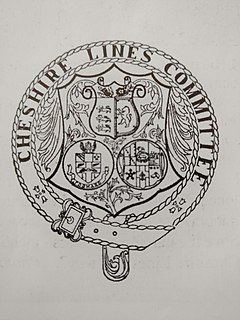
The Cheshire Lines Committee (CLC) was formed in the 1860s and became the second-largest joint railway in Great Britain. The committee, which was often styled the Cheshire Lines Railway, operated 143 miles (230 km) of track in the then counties of Lancashire and Cheshire. The railway did not get grouped into one of the Big Four during the implementation of the 1923 grouping, surviving independently with its own management until the railways were nationalised at the beginning of 1948. The railway served Liverpool, Manchester, Stockport, Warrington, Widnes, Northwich, Winsford, Knutsford, Chester and Southport with connections to many other railways.
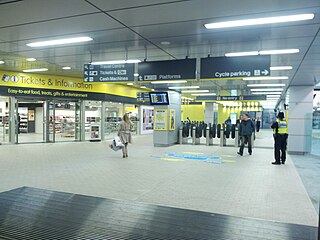
Liverpool Central railway station in Liverpool, England, forms a central hub of the Merseyrail network, being on both the Northern Line and the Wirral Line. The station is located underground on two levels, below the site of a former mainline terminus. It is the busiest station in Liverpool, though considerably smaller than Lime Street station, the mainline terminus, and the busiest station to operate fully the Merseyrail network. In terms of passenger entries and exits between April 2010 and March 2011, Liverpool Central is the seventh-busiest station outside London. The station is the busiest underground station outside London serving 40,000 people daily. The station in passengers per platform is the busiest underground railway station in the United Kingdom at 5,217,547 per platform per annum and laying third in all stations, underground or overground.

Liverpool Exchange railway station was a railway station located in the city centre of Liverpool, England. Of the four terminal stations in Liverpool's city centre, Exchange station was the only station not accessed via a tunnel.

Wigan North Western railway station is one of two railway stations serving the town centre of Wigan, Greater Manchester, England.
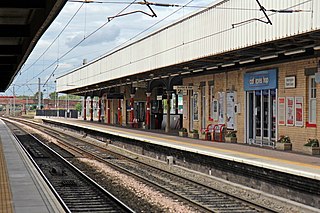
Warrington Bank Quay railway station is one of two railway stations serving the town centre of Warrington in Cheshire, England. Warrington Bank Quay is a north-south oriented mainline station on one side of the main shopping area, with the west-east oriented Warrington Central on the other side to the north west operating a more frequent service to the neighbouring cities of Liverpool and Manchester. Cheshire Cat Buses are operated from the station into Warrington Bus Interchange and in the opposite direction to the Centre Park business park, Stockton Heath and further south into Cheshire. The station is directly on the West Coast Main Line.

There once were four direct railway routes between Liverpool and Manchester in the North West of England, however only two remain, the two centre routes of the four. The most northerly and the most southerly of the four routes are no longer direct lines. Of the remaining two direct routes, the northern route of the two is fully electric with the now southern route a diesel-only line. The most northerly of the four, has been split into two routes, with the western section operated by Merseyrail electric trains and the eastern section by diesel trains, requiring passengers to change trains between the two cities. The fourth route, the most southerly of the four, has been largely abandoned east of Warrington, with the remaining section mostly catering for freight trains.

Gatley railway station is on the Styal Line between Slade Lane Junction in Longsight, Manchester and Wilmslow, Cheshire. Opened by the London & North Western Railway in 1909, it was known as Gatley for Cheadle before being renamed Gatley on 6 May 1974. It serves Gatley, a commuter suburb in Stockport, Greater Manchester. The station is operated by Northern.

Chinley railway station serves the village of Chinley in Derbyshire, England. The station is 17 1⁄2 miles (28.2 km) south east of Manchester Piccadilly, on the Hope Valley Line from Sheffield to Manchester. It is unstaffed, and is managed by Northern.

Hazel Grove railway station is on the Stockport to Buxton / Sheffield line, serving the village of Hazel Grove, Greater Manchester, England. It was built for the Stockport, Disley and Whaley Bridge Railway by the London and North Western Railway and opened on 9 June 1857. From 1923 until 1948 it was owned by the London Midland and Scottish Railway and following nationalisation it was operated by the London Midland Region of British Railways.
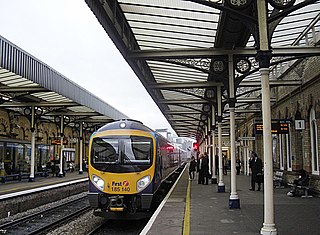
Warrington Central railway station is one of two main railway stations serving the town of Warrington in the north-west of England. It is located on the southern route of the Liverpool to Manchester Lines, being situated approximately halfway between the two cities. Central station is served by diesel stopping trains between Liverpool and Manchester, and diesel express services between Liverpool and Manchester Airport, as well as between Liverpool and East Anglia.

Garston railway station was a railway station in the Garston district of Liverpool, England. The station was located on the Northern Line of the Merseyrail suburban rail network. The station was closed in 2006 when it was replaced by Liverpool South Parkway, which is a combined bus and rail interchange. The proximity of the stations was so close the platforms of South Parkway nearly merged onto the Garston station's platforms.

Liverpool South Parkway station is a railway station and bus interchange in the Garston district of Liverpool, England. It serves, via a bus link, Liverpool John Lennon Airport in the neighbouring suburb of Speke, as well as providing an interchange between main line services and the Merseyrail rapid transit/commuter rail network.
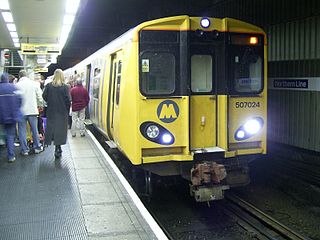
The Northern line is one of the two Cross-city route commuter rail lines operated by Merseyrail in Merseyside, England, with the Wirral Line being the other. A third line, the City Line, is not owned or operated by Merseyrail. All three lines are funded by Merseytravel.

Greenbank railway station serves the village of Hartford, Cheshire as well as the Greenbank and Castle areas of Northwich, Cheshire, England. The station is situated on the A559 road from Northwich to Chester.

Whiston railway station serves the village of Whiston in Merseyside, England. The station, and all trains serving it, are operated by Northern. It lies on the electrified northern route of the Liverpool to Manchester Line, the original Liverpool and Manchester Railway 7 1⁄2 miles (12 km) east of Liverpool Lime Street. It was opened in October 1990 by British Rail, at a cost of £420,000.

Liverpool Central High Level was a terminus railway station in central Liverpool, England. It opened on 1 March 1874, at the western end of the Cheshire Lines Committee (CLC) line to Manchester Central. It replaced Brunswick as the CLC's Liverpool passenger terminus, becoming the headquarters of the committee.
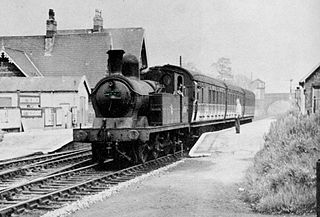
Northenden railway station in Sharston, Manchester, England, was built by the Stockport, Timperley and Altrincham Junction Railway (ST&AJ) and opened for passenger and goods traffic on 1 February 1866.
Allerton Junction is an at grade junction signal box just east of Liverpool South Parkway, Allerton, Merseyside. It takes its name from the former Allerton station that South Parkway replaced.

The Northern Hub is a rail programme in Northern England to improve and increase train services and reduce journey times between its major cities and towns by electrifying lines and removing a major rail bottleneck in Manchester. It is predicted to stimulate economic growth in the region. The project has several elements but the prime objective is to eradicate the bottleneck in Manchester and allow trains to travel through the city at speed without stopping. The project was announced as the Manchester Hub in 2009. The project's steering partnership involves Network Rail, Deutsche Bahn, First TransPennine Express, Northern Rail, East Midlands Trains, CrossCountry, Freightliner, the Department for Transport, Transport for Greater Manchester and Merseytravel.



















